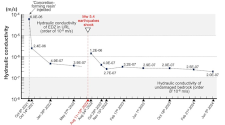
Richard Metcalfe co-authored a recent Open Access paper in Nature Communications Engineering: Yoshida et al. “Post-earthquake rapid resealing of bedrock flow-paths by concretion-forming resin”.
The paper presents an innovative resin-based technology for rapidly and permanently sealing fluid flow pathways in rocks, developed in Japan by a team led by Prof. Hidekazu Yoshida of Nagoya University, with members from The University of Tokyo, Sekisui Chemical Co., the Japan Atomic Energy Agency, Taisei Corporation, and Gifu University. The technology is based stimulating calcite formation by processes similar to those by which natural calcite (CaCO₃) concretions form in rocks. The method was tested by sealing flow paths next to a tunnel in an underground research laboratory (URL) at 350 m depth, in Hokkaido, Japan. Seals formed by the technology have the potential to re-seal should they be damaged by processes such as earthquakes, as was demonstrated in the underground experiments, when the URL was affected by repeated earthquakes with magnitudes up to Mw 5.4.
